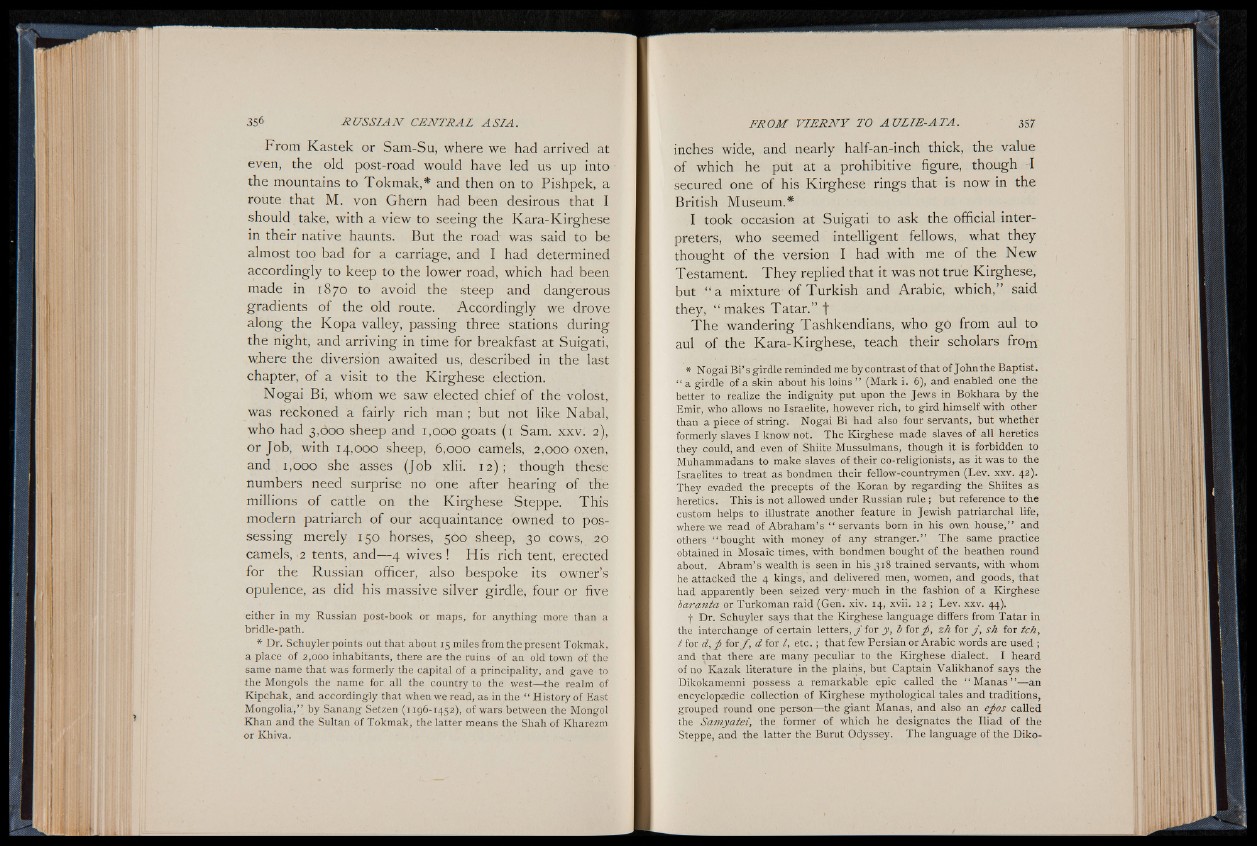
From Kastek or Sam-Su, where we had arrived at
even, the old post-road would have led us up into
the mountains to Tokmak,* and then on to Pishpek, a
route that M. von Ghern had been desirous that I
should take, with a view to seeing the Kara-Kirghese
in their native haunts. But the road was said to be
almost too bad for a carriage, and I had determined
accordingly to keep to the lower road, which had been
made in 1870 to avoid the steep and dangerous
gradients of the old route. Accordingly we drove
along the Kopa valley, passing three stations during
the night, and arriving in time for breakfast at Suigati,
where the diversion awaited us, described in the last
chapter, of a visit to the Kirghese election.
Nogai Bi, whom we saw elected chief of the volost,
was reckoned a fairly rich man; but not like Nabal,
who had 3,000 sheep and 1,000 goats (1 Sam. xxv. 2),
or Job, with 14,000 sheep, 6,000 camels, 2,000 oxen,
and 1,000 she asses (Job xlii. 12); though these
numbers need surprise no one after hearing of the
millions of cattle on the Kirghese Steppe. This
modern patriarch of our acquaintance owned to possessing
merely 150 horses, 500 sheep, 30 cows, 20
camels, .2 tents, and— 4 wives ! His rich tent, erected
for the Russian officer, also bespoke its owner’s
opulence, as did his massive silver girdle, four or five
either in my Russian post-book or maps, for anything more than a
bridle-path.
* Dr. Schuylerpoints out that about 15 miles from the present Tokmak,
a place of 2,000 inhabitants, there are the ruins of an old town of the
same name that was formerly the capital of a principality, and gave to
the Mongols the name for. all the country to the west— the realm of
Kipchak, and accordingly that when we read, as in the “ History o f East
Mongolia,” by Sanang Setzen (1196-1452), of wars between the Mongol
Khan and the Sultan of Tokmak, the latter means the Shah of Kharezm
or Khiva.
inches wide, and nearly half-an-inch thick, the value
of which he put at a prohibitive figure, though I
secured one of his Kirghese rings that is now in the
British Museum.*
I took occasion at Suigati to ask the official interpreters,
who seemed intelligent fellows, what they
thought of the version I had with me of the New
Testament. They replied that it was not true Kirghese,
but “ a mixture of Turkish and Arabic, which,” said
they, “ makes Tatar.” t
The wandering Tashkendians, who go from aul to
aul of the Kara-Kirghese, teach their scholars from
* Nogai B i’ s girdle reminded me by contrast o f that of John the Baptist,
“ a girdle of a skin about his lo in s ” (Mark i. 6), and enabled one the
better to realize the indignity put upon the Jews in Bokhara by the
Emir, who allows no Israelite, however rich, to gird himself w ith other
than a piece of string. Nogai Bi had also four servants, but whether
formerly slaves I know not. The Kirghese made slaves of all heretics
they could, and even of Shiite Mussulmans, though it is forbidden to
Muhammadans to make slaves of their co-religionists, as it was to the
Israelites to treat as bondmen their fellow-countrymen (Lev. xxv. 42).
They evaded the precepts of the Koran by regarding the Shiites as
heretics. This is not allowed under Russian rule ; but reference to the
custom helps to illustrate another feature in Jewish patriarchal life,
where we read of A braham’ s “ servants bom in his own house,” and
others “ bought with money of any stranger.” The same practice
obtained in Mosaic times, with bondmen bought of the heathen round
about. Abram’ s wealth is seen in his 318 trained servants, with whom
he attacked the 4 kings, and delivered men, women, and goods, that
had apparently been seized v e ry much in the fashion of a Kirghese
baranta or Turkoman raid (Gen. xiv. 14, xvii. 12 ; Lev. xxv. 44).
f Dr. Schuyler says that the Kirghese language differs from Tatar in
the interchange of certain le t te r s ,/ fo r y, b fo r / , zh for 7', sh for tch,
t for d, ft fo r / , d for 7, etc. ; that few Persian or Arabic words are used ;
and that there are many peculiar to the Kirghese dialect. I heard
of no K a zak literature in the plains, but Captain Valikhanof says the
Dikokamenni possess a remarkable epic called the “ M an a s ” — an
encyclopsedic collection of Kirghese mythological tales and traditions,
grouped round one person— the giant Manas, and also an eftos called
the Samyatei, the former of which he designates the Iliad of the
Steppe, and the latter the Burut Odyssey. The language of the Diko